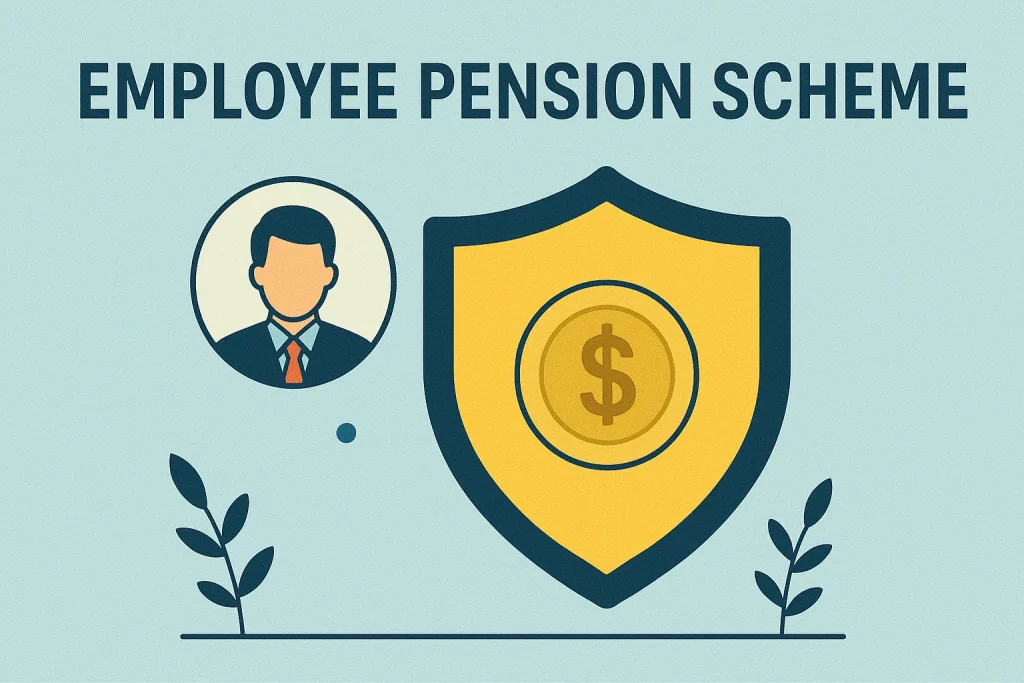Please follow the steps below to use this EPF calculator –
- Enter Your Monthly Basic + DA Salary: This is the amount on which your EPF contributions are calculated. For example, if your basic salary plus dearness allowance is ₹50,000, just type 50000 in the first field.
- Input the Contribution Rate (%): By default, the employee contribution rate is 12%. If you contribute a different percentage, type that in here.
- Enter the Number of Years (Tenure): Think about how long you plan to work before retirement or withdrawal. If it’s 20 years, type 20 in the third field.
- Click the “Calculate” Button: Hit the Calculate button and the calculator will show your total EPF value after the entered number of years. It also visually breaks down how much comes from your contribution and how much is earned as interest.

The Employee Pension Scheme (EPS), launched by the Government of India in 1995, is designed to provide financial security to employees after retirement. Here are some of the major features that make EPS a crucial part of your retirement planning:
- Guaranteed Monthly Pension: EPS offers a lifelong monthly pension to employees after retirement. The pension amount is predetermined and continues for the lifetime of the individual.
- Part of EPF Contributions: EPS is automatically linked to your Employee Provident Fund (EPF) account. Out of the 12% employer contribution to EPF, 8.33% goes directly to EPS, making it a seamless investment without extra effort.
- Minimum 10 Years of Service Required: To be eligible for pension under EPS, you must complete at least 10 years of continuous service. However, you don’t need to work for the same employer throughout.
- Pension Starting Age is 58: You can start receiving pension from the age of 58 years, though early pension can be claimed from age 50 with a reduced amount.
- Pension for Family After Death: In case of the member’s demise, the spouse and children are eligible to receive a pension. This makes EPS not just a retirement tool but also a social security scheme.
- No Interest Earned: Unlike EPF, EPS does not earn interest over time. The benefits are fixed and calculated using a standard formula.
- Pension Calculation Formula: The pension amount is calculated as:
(Pensionable Salary × Pensionable Service) / 70
Here, Pensionable Salary is the average of the last 60 months’ basic salary and Pensionable Service is the number of years you’ve worked.
How Does EPS Work?
When you’re employed and enrolled in EPF, your employer’s contribution is split – 3.67% goes to EPF and 8.33% goes to EPS.
This contribution continues until you retire, switch jobs, or exit the scheme.
Once you complete 10 years of service, you’re eligible for a monthly pension post-retirement.
In case you leave your job before completing 10 years, you can withdraw the amount deposited under EPS, but you won’t be eligible for a pension.
Who Should Invest in EPS?
EPS is not a voluntary scheme – it’s automatically applicable to salaried employees earning a basic wage of up to ₹15,000/month and enrolled in EPF. But here’s who benefits the most:
Salaried Employees in the Private Sector
EPS ensures a secure income after retirement, which is especially valuable for private sector employees who may not have government pensions.
Those With Long-Term Employment
If you plan to work for 10+ years, EPS is highly beneficial. The longer your service, the higher your pension.
Employees Looking for Passive Post-Retirement Income
EPS guarantees stability and assurance, making it ideal for individuals who want a fixed pension income rather than relying only on market-linked retirement schemes.